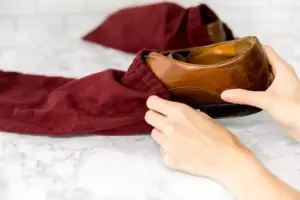How use Rit Dye on Leather
Are you considering using Rit dye to add color to your leather items? Or perhaps you have a faded leather piece that you’d like to refresh with a new hue.
While Rit dye is a popular option for adding color to fabric, you may be wondering if it is effective on leather.
In this article, we’ll answer the question of whether Rit dye works on leather, how to use it, and the supplies you’ll need. We’ll also provide some tips for getting the best results when dyeing leather.

Does Rit dye work on leather?
Yes, you can use rit dye on leather and it does work. Although it is not specially designed for leather, it adds color to leather giving it a bold and unique look. However, it may not work on all types of leather and it may not give the same level of colorfastness or durability as a leather dye.
Type of leather suitable for Rit dye
As aforementioned, Rit dye does not work on types of leather as some absorb the dye more readily than others. These are;
- Unfinished or full-grain leather
Unfinished leather has not been treated with a protective finish so it is highly absorbent. Its natural texture allows it to absorb Rit dye more easily than other types and gives a more vibrant and consistent color than finished leather.
Full-grain leather is also more receptive to dye because it has not been sanded or buffed and it is more porous compared to corrected-grain leather.
- Suede leather
Suede is also a type of leather that has a soft and velvety finish. It is highly absorbent which allows it to take in the dye more readily than smooth leather.
- Nubuck leather
Nubuck is similar to suede but with a brushed finish and a slightly firmer texture. It is also quite absorbent and absorbs Rit dye easily.
However, it is important to note that the effectiveness of Rit dye on any particular type of leather can depend on a variety of factors including the age and condition of the leather and the dye application process.
For instance, if the leather is dry and damaged, it may be difficult for the dye to penetrate the surface.
It is therefore advisable to test the dye on a small and inconspicuous part of your leather item before proceeding with the dyeing process.
Doing this can also help you to gauge the color and ensure that you achieve your desired results.
How to dye leather with Rit dye
You will need; Rit dye, rubber gloves, a plastic container, and a brush or a sponge.
Step 1: Prepare the leather
For the dye to adhere properly, your leather needs to be free of dirt and debris.
Start by thoroughly cleaning the leather and removing any residue from the surface especially if there is peeling.
You can use leather cleaner or a mild soap but be sure to rinse off thoroughly once done.
Additionally, repair any cracks or scratches before starting the dyeing process.
Step 2: Moisten the leather
Keeping the leather moist before applying the dye can help the dye to penetrate the leather surface more easily.
You can do this by wiping the leather down with a damp cloth or spritzing. Blot off any excess water with a dry cloth before proceeding.
Step 3: Mix the dye
If you don’t get your desired Rit dye color, you will need to mix several different colors to achieve it.
Just follow the instructions on the dye package to mix it correctly.
Step 4: Apply Rit dye
The way you apply the dye can also determine the final results since it affects the ability of the dye to penetrate the leather.
For instance, using a sponge or a brush to apply the dye can help to ensure that it is spread evenly and that it penetrates the surface more deeply.
You can also use a spray bottle to apply the dye since it’s quicker. But first, remember to cover the areas that you don’t want to dye with masking tape or plastic wrap.
Step 5: Let the dye set
Once done with the dye application, allow it to penetrate deep into the leather for a while as recommended by the dye manufacturer.
Most people prefer to leave it overnight to enable to dye to set properly.
Step 6: Seal the leather
One major problem with Rit dye is that it tends to rub off after a while. To prevent this, it’s advisable to seal the leather after applying the dye.
There are different types of sealants you can use but choose one that will provide the appropriate protection and prevent the dye from coming off even when exposed to water.
Conclusion
Using Rit dye to color leather can be a fun and creative way to give new life to old leather items or to add a touch of color to your wardrobe.
While it is possible to dye leather using Rit dye, it is important to prepare the surface of the leather properly and to follow the instructions provided by the dye manufacturer carefully to achieve the best results.
To prevent dye from rubbing off or fading over time, it is also a good idea to apply a sealant to the dyed leather and to handle it gently. However, if this doesn’t work for you, you can try other leather-dye alternatives like coffee.




